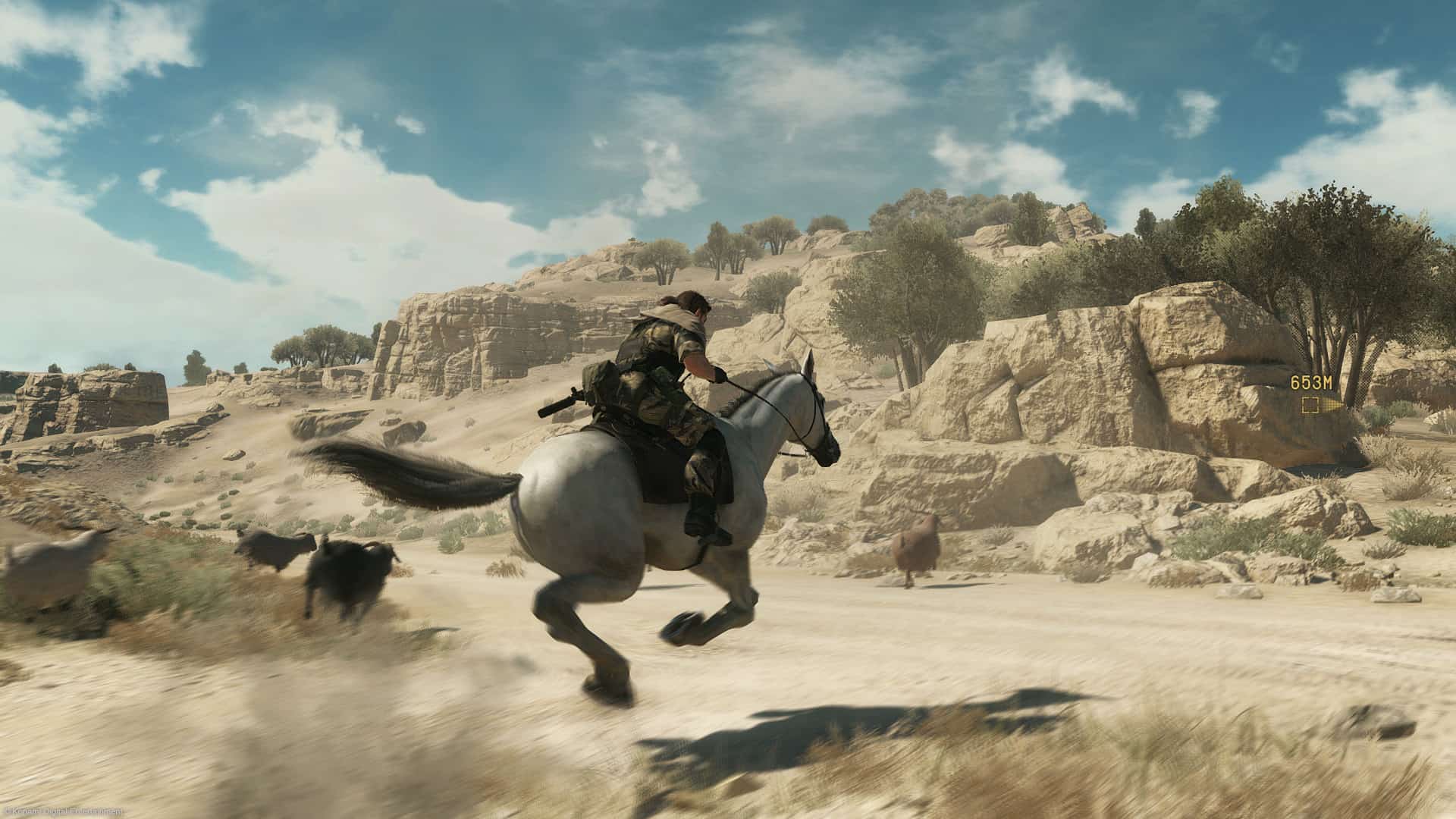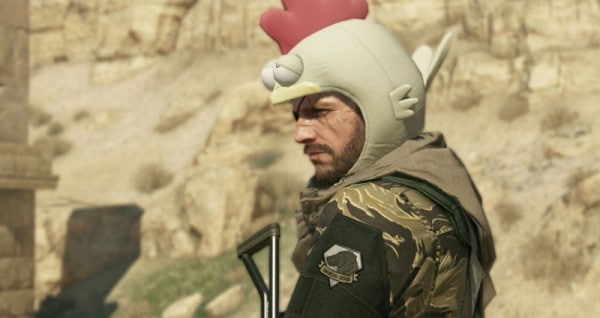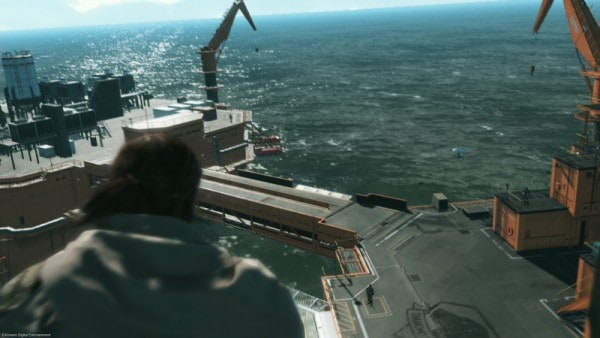Metal Gear Solid has traditionally been about successive corridors, lengthy cinematics, and narrative inertia. Each military compound, ruined city, or virgin forest would lead to the next and players would run or crawl or tiptoe headlong into an epic finale. Environments would be interactive and dense with secrets, but they would also be small and the connections between them straightforward. Players would feel trapped, stuck to a conveyor belt. Which was thematically apt because the protagonists were always pawns, susceptible to betrayal. Metal Gear Solid investigated what freedom and agency mean in designed products like video games, long before the theme became fashionable after Portal and The Stanley Parable.
Now we have The Phantom Pain. Our hero, Venom Snake, no longer takes orders from anyone. He’s his own Big Boss! And so the game naturally opens up. Vast terrains, humid grasslands, and sandy mountains; dozens of bite-sized missions that fragment your global destinations; a narrative weaved less during cutscenes than through marginalia like audio recordings. Gameplay can be chaotic. There are few rigid and linear paths, only a broad perimeter and scattered enemy locations. Anything, it seems, is possible.
In one mission, I am helicoptered into an African savannah. My mission is to track and kill a trafficker, but the savannah is too extensive to find him without guidance. I then learn a nearby enemy outpost has intel on his location, so I stealthily approach it with the most peaceful of intentions. That is, until a surprise gunship spots me and forces me to ditch my non-lethal sniper rifle and whip out a rocket launcher. Vehicles and people explode. Soon everyone at the outpost is either crisp or unconscious. Quiet, my sister-in-arms, helps me out with some sniping of her own, although she can do nothing against one heavily-armored individual. I make sure he goes down with the same thunderous applause that felled the gunship.
I recover the intel and set out to locate my target. I don’t. He manages to cross the savannah and nestle into another enemy outpost. Unfazed, I order Quiet to attack the base while I wait outside. Everyone there goes nuts, screaming at each other to find the sniper, find the sniper! They don’t. The stupidest one of them all happens to be my target. In his quest to escape, he runs from the outpost and blunders straight into my hiding place. I do short work of him. Mission accomplished.
This anecdote neatly sums up The Phantom Pain. What it does not sum up is every other Metal Gear Solid. That is, besides Peace Walker. Hideo Kojima has always been one bold dude, and one of his bolder moves, in this case, is making the most crucial predecessor in the franchise, as far as understanding the plot and gameplay goes, a portable and non-numbered entry. Like it, albeit on a grander scale, The Phantom Pain is committed to openness, to freedom. It wants players to chill, to accept missions according to their fancy, to complete side ops, to crawl through the mud while listening to taped conversations or David Bowie. Gone is the tunnel vision, the pull, the rush to the end of Metal Gear Solid. In its place is relaxed experimentation and spurred curiosity, which is what the sandbox genre always promises but often bores us with.
The Phantom Pain works where other titles of its kind do not because the franchise has never actually needed that much space to provide fun. Even in close quarters, in tiny offices and narrow tunnels, the stealth mechanics have always been deep enough, entertaining enough, to see us through. We now have a larger playground to test our moves, but the mechanics don’t require it, they merely welcome it. Most sandboxes give us a massive place that’s awesome in its totality but dull in its particulars. We have many places to see, but little to do in them. The Phantom Pain, on the other hand, carries the robust legacy of Metal Gear Solid on its shoulders. We can duck, punch, kick, interrogate, hide, shoot, knife, bug, listen, read, extract, and engage in a million other activities. We have done it in the past, in stricter confines, and we can definitely do them now in wider tracts of land.
This commitment to openness does have its drawbacks and hilarious excesses. One of the most glaring is the bungled transition between missions 28 and 29. After extracting an old man, the mysterious Code Talker, my chopper is struck down by unnatural mist. Right before I crash, however, the dreaded to-be-continued words flash on the screen. Moments later, I am sitting comfortably inside the same chopper that should be nose-diving into an African airfield. (This is the game’s glorified mission-select screen, where we usually relax after successful outings, which number 28 is not.) For reasons that defy logic, I can now travel around the globe, manage my bases, develop weapons, and so on. I can do this for hours and hours. Is this the afterlife?
Alas, when I begin mission 29, I resume my interrupted fall, as if I had been straddling parallel universes. The Phantom Pain is so obsessed with its mission-based structure, is so determined that players be able to do whatever they want, that it never suppresses that freedom or bends that structure, even when the story calls for it. Simply put, we should not be able to do anything between missions 28 or 29 that does not involve falling from the sky, because people who fall from the sky, I have it on good authority, cannot take breathers to jam to 80s rock.
Realism is not the point here. I am talking about immersion, something Metal Gear Solid has always excelled at. The linearity of earlier titles meant our sights were always on the ultimate goal. If we were in danger, there was no escape, no sitting back. We had to beat the challenge, overcome the obstacle. Difficult bosses or set pieces were serious business. We could do nothing else but try to surpass them. No base management, no side-questing. All of this ensured we were in the zone, attuned to the pressures and obstacles of our immediate surroundings.
The Phantom Pain loses this immediacy. It gains in creative possibilities, but at a price. The image of our protagonist in his chopper, journeying over continents, seems to mirror our detached, hovering engagement with the virtual world. We helicopter in and out of areas like we run in and out of villages. The guards usually don’t trouble us when we’re far from their posts; the narrative keeps its distance when we’re accumulating frequent flyer miles on our chopper. We’re always there and not there, straddling alternate universes. I haven’t finished the game yet, so I can’t give a final opinion. I can only profess my undying love for it while also recognizing that earlier Metal Gear Solids remain far from obsolete. They still pack a punch that The Phantom Pain fails to emulate.




